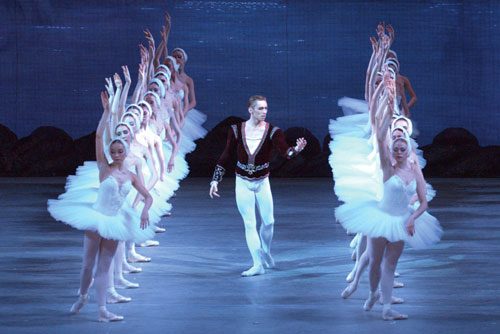Henrik teaches French #6: Corps de ballet
If the principle dancer of a company is the hollywood-star, the corps de ballet is the working-class heroes of the ballet world. They are the biggest group of a company, all the dancers that performs roles that doesn’t have names. They are the “guys” from the two families in Romeo and Juliet, the swans that make Swan Lake, the women in the lines and the men that lifts them. The corps de ballet are the dancers that go out there, every day, does their tendues, waiving their roses, holding their lines. It’s the main role of 90 percent of all dancers.

Swan lake is a good example of the importance of the corps…
Now, that doesn’t mean the corps-dancers (not to be mixed up with corpse-dancers) have an easy job. Actually, I’d say the corps-dancers have the hardest job a lot of times. The principle goes on stage, and dances short dances, and usually the big pas de deux’s (pas-de-what? Click here for some enlightening). He (or she, for that matter, but let’s stick with the male form for grammars sake) does the tricks, the grand lifts, definitely the heavier elements, but then he takes a bow, and it’s 20 minutes ’till he returns on stage. Now, what happens on stage between the variations of our hollywood-stars? The corps does their magic. All the dances that sets the setting of a ballet, is performed by the corps. They are the dancers that separates a full-length ballet from a gala-performance. The happy crowds in Don Quixote, the mourning families in Romeo and Juliet, the soldiers and slaves of Spartacus, they are all dancers from the corps.
While it is completely unthinkable that a soloist performing a role will change costumes and go back on stage in a different role the next act, this is what the corps-dancer faces every day. Go on stage, do your thing. No applause or bows, the show must go on. But the dancer runs down to his changing-room (or even just off-stage, in the wings, if the time is short), puts on a different set of clothes, some change in make-up, and you are on stage again. A dancer from the corps usually dances at least a couple of roles in a full-length ballet.
As far as french concerns, Corps de ballet is another great example why the terms we use are so good: Directly translated, it means the body of the ballet, or the ballet’s body.
I wrote a post earlier on hierarchy in the theatre, go check it out to get a (somewhat ironic) overview of the pecking order in a normal theatre.
Until next time, Ta-ta
H


